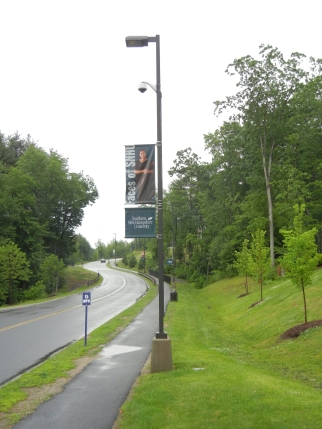The novel Lives of Girls and Women, though considered more of a series of connected short stories by many, is loosely based on the author Alice Munro’s childhood and adolescence, and chronicles the early life of Del Jordan, the narrator whose first name doesn’t appear until page 49 in chapter two. Each self-contained chapter reveals a year in the life of this amazingly bright young girl and the eccentric people who inhabit her small town world. Munro’s writing is full of intricate descriptions of landscapes and people, wonderful and witty one-liners, and complex sentences that reveal the mood of the characters surrounding Del’s ordinary, yet interesting life.
I enjoyed the book so much I found it difficult to narrow down the great quotable material that exists throughout. Starting with chapter one, “The Flat Roads,” Munro opens with wonderful descriptions of the countryside outside the town of Jubilee, of Uncle Benny, the first of many interesting characters, and gives one of her many clever one-liners. The first one appears on page one about Uncle Benny. “He was not our uncle, or anybody’s.” It made me want to read further to find out who this man was and how he was related to the narrator. He turns out to be a neighbor who marries a young crazy woman after answering a classified advertisement in the newspaper (Hum, sounds vaguely familiar, like something I’m currently working on). Then Del shares her opinion of her Uncle Craig, who really is her uncle. She doesn’t really care what he thinks of her because his “Masculine self-centeredness made him restful to be with” (35).
In chapter four “Age of Faith,” a powerful part of Del’s journey toward womanhood, includes her curiosity about spirituality and religion, a common pursuit for many as they mature. Or at least, it was for me and my daughters. After my parents became disillusioned with their church, I started attending church with various friends and explored the many options before deciding I was more spiritual than religious. I related to the narrator when she said, “I realized that I did not care a great deal . . . about Christ dying for our sins. I only wanted God. But if Christ dying for our sins was the avenue to God, I would work on it” (119). My daughters, too, went through a similar phase, attending church with their friends, searching for answers to such questions Del asked, like “If He made everything the way He wanted it then nothing was to blame for being the way it was, and this more or less threw out, didn’t it, the whole idea of sin?”(121). My eldest was even talked into being baptized, though later she said she didn’t really understand why. Del, strong character that she is, wasn’t one to be talked into being baptized or doing anything she didn’t want or understand. Here’s another great one-liner that came from this chapter: “Seeing somebody have faith, close up, is no easier than seeing someone chop a finger off” (128).
Not only does Munro write great one-liners, but also sentences that contain life’s ambiguities by presenting contradictory statements such as how Del felt as she read magazines similar to today’s “National Enquirer.” “I was bloated and giddy with revelations of evil, of its versatility and grand invention and horrific playfulness” (8). And another example is the description of her mother and aunts. Their differences are highlighted with poetic precision. “My mother’s disapproval was open and unmistakable, like heavy weather; theirs came like tiny razor cuts, bewilderingly, in the middle of kindness. They had the Irish gift for rampaging mockery, embroidered with deference” (43). When her aunts give her Uncle Craig’s manuscripts about the history of Wawanash County (spell-check thought the word “Wawanash” should be “womanish” which I thought funny and appropriate) and their family genealogy, Del feels “remorse, that kind of tender remorse which has on its side a brutal, unblemished satisfaction” (71).
There are great descriptions of the inner-workings of women in this story, especially of her mother. “Sometimes my mother would assemble everybody to look at the sunset, just as if it was something she had arranged to put on” (27). Her mother’s relationship with her sister-in-laws, Del’s aunts, is even more interesting. “My mother went along straight lines. Aunt Elsperth and Auntie Grace wove in and out around her, retreating and disappearing and coming back, slippery and soft-voice and indestructible. She pushed them out of her way as if they were cobwebs . . .” (42-43). Chapter three “Princess Ida” is devoted entirely to Del’s mother, who is based on Munro’s mother because she is her “central material in life, and it always comes the most readily” to her (Paris Review, 6).
After reading Lives of Girls and Women, I found myself liking its author Alice Munro, and while reading an interview in the Paris Review, I felt a connection with the writer. Three words that come to mind when thinking of her are humble, refreshing, and reassuring. Her interviewers stated that even with her “considerable accomplishments, Munro still speaks of writing with some of the reverence and insecurity one hears in the voices of beginners” (1). Munro admits to being “the opposite of a writer with a quick gift” though you would never know it by reading her material. Her process of writing takes time as does mine. I understand exactly how she feels, and was reassured knowing I’m not alone, when she says she might think she’s done well one day, and then feel depressed and “on edge” the next because she thinks her writing isn’t going well and she’s not sure if she has it in her to complete her work (7-8). She steers “clear of the literary world” because, as she puts it, she “grew up on a margin,” “out of any mainstream” and she “knew there was something about the great writers” she “felt shut out from” (17-18). Because she has lived an ordinary domesticated life as a housewife and mother, she was intimidated by literary writers “who understood a lot more . . . about what they were doing. And talked a lot about it. And were confident in a way that would be acknowledged to have a more solid basis than” hers, because her “writing wasn’t fancy” (18). As I’m reading her interview, I’m saying, “Yes, yes, yes, I can relate.” (Even her writing schedule is the same as mine!) I know exactly what she means, and I would have never thought her this way by reading her novel. Her lack of confidence ironically gives me more confidence. If she can do it, maybe I can, too. And though I may never write as well or accomplish as much as Munro, I certainly plan on reading more of her work.
Works Cited










